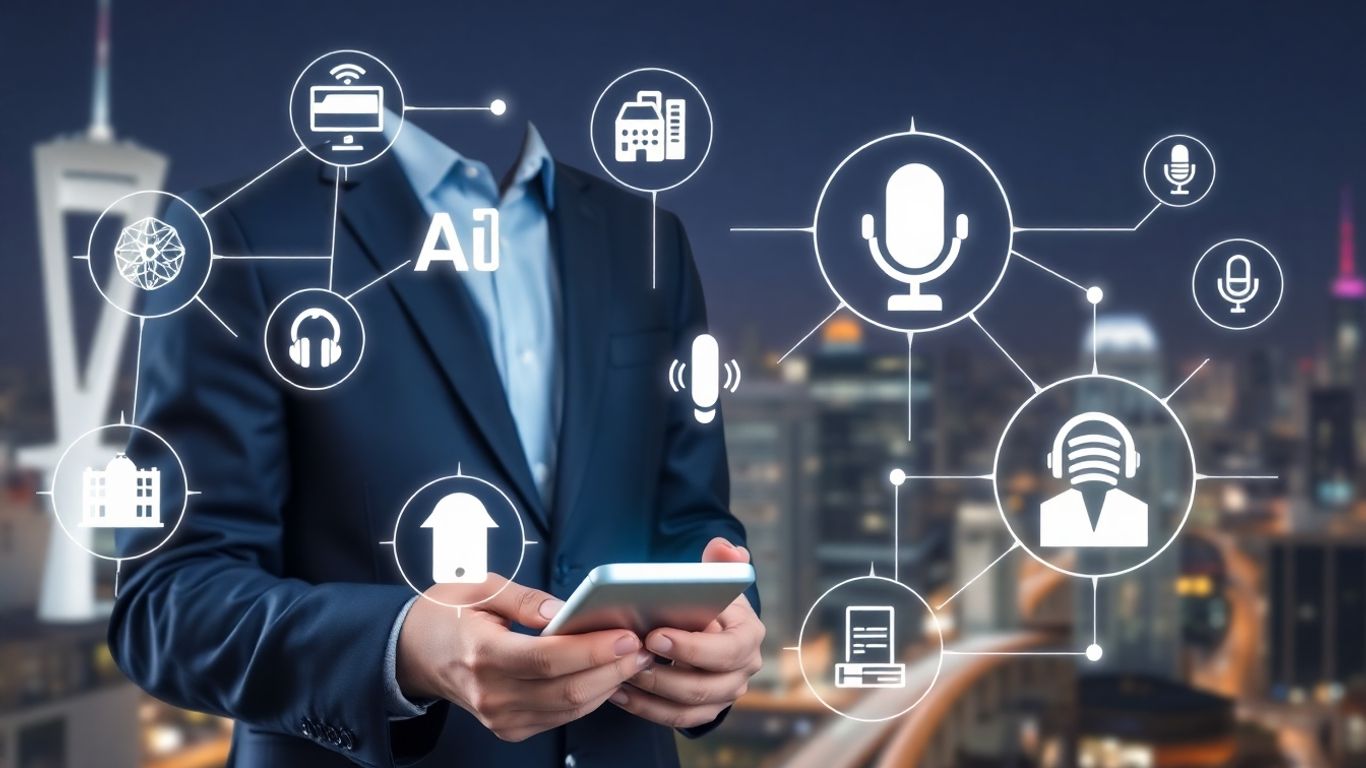AI isn’t just a buzzword anymore—it’s changing how we handle phone calls in 2025. Now, AI helps complete first voice call using advanced automation, making every call smoother and faster. Whether you’re running a small business or a giant call center, AI voice agents can answer, schedule, follow up, and even update your CRM—all without a person picking up the phone. It’s not just about saving time, but making sure no call slips through the cracks. Let’s break down how this works and why it matters for your business.
AI has taken phone calls into new territory this year. What used to need teams of agents and layers of managers now unfolds without people ever picking up the handset. But it's not just about cutting jobs or saving time—it's how the system does the job itself, and why automation is finally working as promised.
Modern AI agents take in not just words, but the way people talk. They catch hesitations, fill in blanks, and answer questions like people would. The difference? AI listens for context, not just for keywords. For instance, if someone says "I'm not sure if I can make it Tuesday, but I'd like to schedule something," the system processes that ambiguity and suggests alternatives—it's not stuck waiting for a direct answer. With each call, models keep learning, so questions rarely stump them for long.
It still surprises me how a first-time caller can tell the AI about missing paperwork or a last-minute cancelation, and the response is as informed as if you’d sent an email days ago.
Speed is everything during a call. No one likes dead air or waiting for a slow system to catch up. AI-powered voice apps now measure response time in milliseconds, making conversations feel natural. The AI doesn't just follow a script. It references previous calls, recalls important dates, and updates records on the fly. This makes the call flow—no long pauses or clunky transitions.
It's like having your best staff working at full focus, every minute, for every client. Some teams are already using solutions that offer 24/7 call answering and real-time scheduling without missing a beat.
Real-world calls don't always stick to a script. Someone changes their mind, forgets a detail, or needs to reschedule several appointments at once. In the past, that meant putting people on hold, making notes, transferring, and sometimes dropping the ball. Now, AI sorts out tangled requests immediately—it won't get flustered.
This isn't the slow IVR tree that makes people press buttons. Modern AI agents solve things as they come up, no babysitting required. And when the call wraps, every step—from scheduling to CRM notes—happens instantly.
The bottom line: The AI voice call platforms of 2025 aren’t just efficient. They’re reliable, always-on partners that get smarter with every interaction—and finally deliver on what business owners have hoped for since the first "press 1" systems rolled out.
Today's AI voice tech does more than just answer phones. The way it hooks into your business tools changes everything. You get a smart layer that moves information, triggers tasks, and never misses a detail—all without the glue and duct tape most legacy call automation systems used to need.
Let's face it: companies run on mixtures of CRMs, weird internal tools, and a parade of SaaS accounts. Most systems don't talk to each other. AI voice assistants are fixing this by plugging straight into tools using Zapier or direct APIs.
It's not just a central control board—it's more like an automated nervous system for the business. For food delivery services, this speed means orders never get lost in the shuffle, improving revenue and customer trust. See how 24/7 call management makes this possible on My AI Front Desk's food service solution.
The old routine was: take a call, scribble details, then hope the CRM gets updated sometime this week. Now, AI agents write it directly into the tools your team actually uses. Here's a breakdown:
No more post-it notes or lost messages—every bit of info sticks where it belongs, the moment it happens.
Automation isn't about replacing your staff, it's about keeping the gears moving so your team can focus on real problems, not just typing the same info twice.
With the right integrations, call events aren't dead ends. They're springboards:
It doesn't even take an IT team to set up—most of this can be turned on in minutes with modern AI phone systems like My AI Front Desk that integrate with thousands of business apps.
Bottom line: when the phones are plugged into everything else, things just work. Less cleanup, less confusion, and a business that never sleeps. This isn't just about more productivity—it's about never letting a customer fall through the cracks, even when you're not looking.

So here's the thing: businesses used to act like telephone lines were some sort of finite resource. But when advanced AI stepped in, that limitation just vanished. Modern AI voice systems can pick up every call—ten calls or ten thousand—without breaking a sweat. Whether it's a post-game ticket rush or a flurry of Monday service requests, the AI keeps up. Scalability actually means something now: your brand comes across the same way to the first caller and the ten-thousandth.
Some reasons why this matters:
If you've ever run a business where missing a call meant missing a sale, you know the headache. AI call automation flips that. The phone lines turn into an open door, not a bottleneck. For businesses serious about never missing an opportunity, check out how an AI receptionist ensures businesses never miss calls.
No one wants to call a place, hang up, and wonder if their request was heard. So AI stepped in and took action: after a call, instant SMS follow-ups confirm what happened, answer extra questions, or send documents without human help. It's kind of wild how easy it becomes to promise “you’ll have that in your inbox” and actually mean it—every time.
Here's what you might see:
The result? Fewer callbacks, clearer communication, and less stress for everyone.
Most callers these days expect confirmation texts, emails, or links after a conversation—AI makes it so they never wait.
I get it: nobody wants to pay for night shifts, but everyone wants 24/7 customer care. AI doesn't sleep. It means customers can reach you anytime, not just "between the hours of nine and five." AI voice agents answer, resolve, and even schedule while you’re asleep or your main office is closed.
The practical magic:
Business doesn’t wait. With modern AI, now neither do your callers.

AI finally sounds like it means it. Not just polite, but actually listening. The latest voice agents can shift from a calm, careful tone for nervous callers to a brisk, cheerful one for those in a rush—all without getting tired or annoyed halfway through. They use real-time cues to measure pacing, patience, and even word choice.
Imagine a receptionist who never sighs, never interrupts, and always waits for you to finish. That’s where we are in 2025. The old stereotype of robotic phone trees is out; adaptability is now the bare minimum.
Human moods swing; AI can stay steady, cool, and endlessly patient, which makes even tough calls simpler for everyone.
Hospitals, debt collectors, even customer support teams are letting AI handle bigger stuff—calls where stress levels run high, and the wrong word can trigger real upset. These systems catch emotion in voices, flagging frustrations or sadness early. That means apologies sound real, not rigid; empathy is built in, not tacked on.
Here’s what makes the difference:
Humans have off days. The magic of AI is it doesn’t. You call at midnight or noon, after a hundred angry callers or the first one—and you’ll get the same answer, measured and clear. No matter how many calls fly in, or if the day’s a total mess, every single customer gets the same level of attention.
The main shift is that reliability is now something you can actually guarantee. That levels the playing field between businesses, making every caller feel seen and heard—every single time.
AI call automation has moved past just picking up the phone and answering basic questions. Every call is now a resource for learning and growth. Systems that constantly update and restructure themselves become an engine for business improvement—no extra effort required. Here’s how this works in practice.
Gone are the days of scribbling notes from calls or missing info entirely. Modern AI voice receptionists now log every conversation, update client profiles, and tag follow-up needs as the call is happening. For example, My AI Front Desk's analytics tools turn raw call data into structured insights in your CRM or help desk with zero manual work.
This automation solves both the tedium and the risk of forgetting key details. Now your sales team always knows where conversations left off.
It’s not just about storing the data. What matters is what the system sees in it. Modern AI phone agents crunch thousands of conversations at once, spatting out trends, customer pain points, and new opportunities. Consider this:
With these summaries visible in real time, business owners can adjust talking points, spot gaps, and even predict customer needs before they’re said aloud.
Call data isn’t static anymore. Every new conversation resets the bar for what “good” service looks like—and it all unfolds automatically.
Of course, an AI receptionist is only as good as its last update. That’s why the best platforms adapt each day, using live customer feedback to squeeze out better performance.
As a result, these systems get sharper over time. AI Front Desk solutions now arrive smarter out of the box, but after a month or two of real calls, they’ll feel like a part of your team—knowing your quirks, jargon, preferred tone, and even your customers’ most common questions. That’s true improvement at scale, and it happens with every single interaction.

Staying on the right side of the law is no small thing for AI-powered calls. One mistake and your whole campaign could stall out, or you could face those expensive legal headaches. AI call automation has to be smart about more than just conversations — the rules are changing fast, and companies that get compliance right move ahead.
If you're calling folks across state lines, the rules change with the area code. Here’s what matters:
Getting consent right isn’t just a checkbox — it’s about trust, and it might be the single thing that protects your business long-term.
Recording calls? Here’s where it often gets tricky:
Laws move quickly. Today’s compliant process might miss something tomorrow. So what do you do?
It’s not flashy, but compliance is your AI calling insurance. Skip it and every other automation win is just one cautionary tale away from disaster.
The days when a virtual receptionist just answered phones are long gone. AI call automation is pushing into places you wouldn’t expect. We’re not talking about minor upgrades, but real, industry-level shifts happening in 2025. Let’s talk specifics—sector by sector, where AI is starting to earn its keep and then some.
Healthcare has been bogged down for years by busy lines, missed calls, and frustrated front desks. AI isn’t just picking up the phone. It schedules patient appointments, verifies insurance, handles prescription refills, and automatically routes calls to the right departments or even to billing—no more waiting for a human to look something up. For after-hours care and pharmacy refills, patients don’t have to wait until the next business day. That level of uptime just isn’t possible with regular staffing.
Human Resources and recruiting have jumped onboard too. AI voice agents can screen applicants, book interviews, and even run through standardized pre-screening questions, trimming days off the hiring process. One big feature: automated interview scheduling linked directly with team calendars.
In government, AI is now fielding calls for permits, appointment requests, and frequently asked questions—reducing lines at physical offices. When records or updates are needed, the system can deliver documents or direct people to the right resources with almost no lag.
Hiring has changed. AI-powered phone calls now handle the first touch—think initial interview. Applicants call in, answer standardized questions, and their responses are instantly scored and logged. No more chasing candidates down by email or trying to find a time for someone to pick up the phone. If something needs a real human, the AI can flag unusual responses for review—so people spend their time only where it matters.
For training, these same agents become role-playing partners. New hires can practice customer calls or even tricky complaint scenarios by speaking with the AI, which adapts its tone and questions. This kind of repetition used to take hours of supervisor time.
When you combine recruiting and training workflows, you get faster onboarding, better screening, and a consistent process that doesn’t depend on who’s working that day.
Businesses are connecting their AI voice systems with SMS, chat, and email workflows. Now, a call can kick off a text reminder, trigger a contract to be sent, or push an update to a CRM—all without asking a human to move data between apps. Tools like advanced AI virtual receptionist features make the whole process more fluid.
Below is a table summarizing industry use cases and common actions automated via AI in 2025:
AI isn’t just answering; it’s becoming the backbone of business communication. Every new use case means fewer bottlenecks, smoother customer journeys, and a stack of problems off your plate. If you’re still thinking of AI as “just a receptionist,” you’re already behind the curve.
There’s a lot more you can do with Frontdesk than just answer calls. Our AI receptionist helps with tasks like setting appointments, sharing information, and even answering common questions. Want to see how it all works? Check out our website to discover fresh ideas to make your business better!
So, here we are in 2025, and AI-powered voice calls aren’t just a tech demo anymore—they’re part of daily business. What used to take a whole team and a mess of tools now happens in the background, quietly and reliably. Calls get answered, appointments get booked, and follow-ups just happen. No more missed leads or endless data entry. It’s not magic, but it kind of feels like it. The best part? You don’t need to be a developer or have some fancy setup. Businesses of all sizes can plug in, turn it on, and see results. AI isn’t replacing people—it’s letting them focus on the stuff that actually matters. If you’re still on the fence, give it a try. You might wonder how you ever did it the old way.
An AI voice call is a phone call handled by a computer program that can talk and listen like a real person. It uses special technology to understand what you say and respond in a natural way. The AI can answer questions, set appointments, and even send follow-up texts, all without a human needing to step in.
Yes! Modern AI voice agents are trained to understand not just simple questions, but also more complicated conversations. They can keep track of what you’re talking about, ask follow-up questions, and even handle tricky situations, just like a skilled human receptionist.
AI voice systems can link up with tools you already use, like your calendar, customer lists, or spreadsheets. With integrations like Zapier, when a call ends or a new appointment is made, your systems update automatically. This means less manual work for you and everything stays in sync.
Most of the time, customers won’t notice unless you tell them. AI voice agents are designed to sound friendly and natural. They can even adjust their tone and patience depending on who’s calling, making the conversation feel real and comfortable.
Yes, as long as you follow the rules. AI call systems can be set up to ask for permission before recording or using customer data. They also adjust to local laws about phone calls and privacy, helping your business stay out of trouble.
Almost any business that uses the phone can benefit, from doctor’s offices and repair shops to schools and government services. AI voice agents can help with scheduling, answering questions, and even handling after-hours calls, making sure you never miss an important message.
Start your free trial for My AI Front Desk today, it takes minutes to setup!








